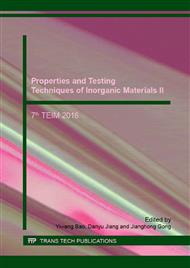p.388
p.394
p.399
p.404
p.409
p.414
p.419
p.424
p.429
Influence of Ionizing Gas Flow on Structural Homogeneity of Type IV Silica Glass
Abstract:
Type IV silica glass is the key material in inertial navigation and optical field due to its high purity and unbroken structural network. Structural homogeneity of type IV silica glass, which is mainly affected by producing process, is one of the most important properties and determines its usability. The influence of ionizing gas flow of plasma was studied in this paper. Flow rate of working gas and protecting gas was changed and the depositing temperature field was measured. Structural homogeneity of deposited silica glass was discussed by optical homogeneity, fictive temperature and stress birefringence. Results show that more uniform temperature field can be obtained with higher working gas flow and lower protecting gas flow, and the structural homogeneity of type IV silica glass is better. But the proportion of working gas and protecting gas should not be larger than 2. When the working gas and protecting gas are 5 m3/h and 2.5 m3/h respectively, the structural homogeneity of type IV silica glass is the best.
Info:
Periodical:
Pages:
409-413
Citation:
Online since:
January 2017
Authors:
Keywords:
Price:
Сopyright:
© 2017 Trans Tech Publications Ltd. All Rights Reserved
Share:
Citation:


